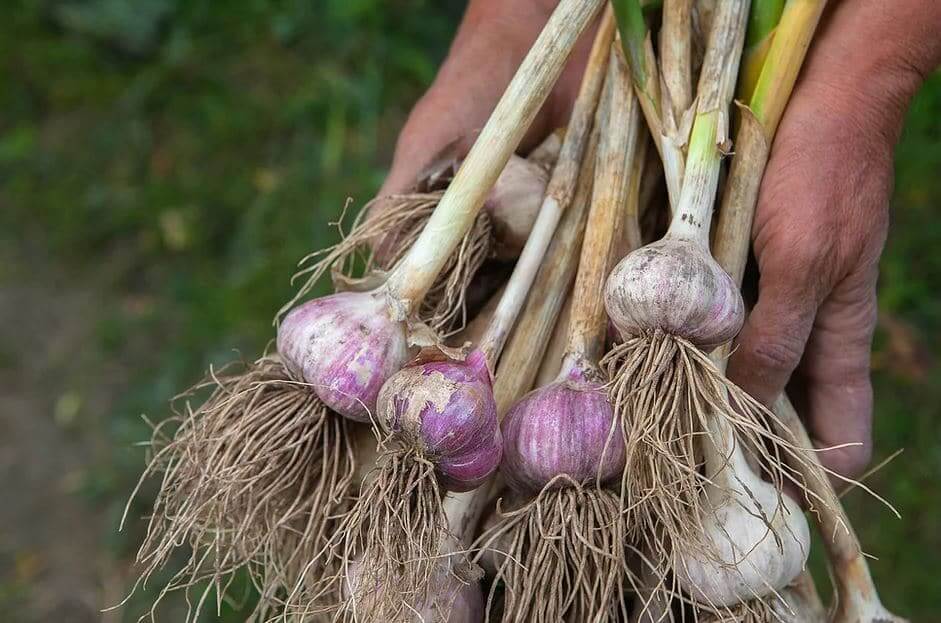
When I first planted garlic, I planned to start it in the spring just like the rest of my vegetables. I took a picture of the already blooming garlic bulb, posted it on social media, and praised the coming growing season. A more seasoned gardener commented, “No, don’t plant that yet. You have to wait until the fall.” Thankful, I asked more questions, did a little digging (pun intended), and learned more about the best time to plant garlic in colder climates.
When to Plant Garlic
Most gardeners plant their garlic cloves in October, and for my fellow high-country gardeners you could start planting your garlic cloves earlier in the month before the snow starts flying around Halloween. If you are familiar with gardening zones, use the guides below.
- Zones 0-3: Late September
- Zones 3-5: Early October
- Zones 5-7: Mid October
- Zones 7-9: November
- Zones 9-10: December
You’ll need to adjust for altitude and cold temperatures, too. For best results, contact your local extension hall; in Grand County, Colorado, the extension hall is the Colorado State University Extension Hall in Kremmling. Also, speak with fellow gardeners in your area; I’m in a local Facebook group of gardeners to rely on for questions. Check to see if you have a group in your area.

Garlic is a very cold tolerant plant and can even grow in the coldest of climates (as long as there isn’t permafrost). Our local area ranges in elevation from 6,000 feet to 10,000 feet and gets 187 inches of average snowfall every winter… and we can still grow garlic. Canadians and Alaska gardeners alike also have great success with growing garlic.
When planted, the garlic has to be able to at least root before it gets too cold. Just after the first frost of the fall is a great time to go ahead and plant your cloves. For colder zones (zones 0-5), look for hardneck garlic varieties, and start with different varieties of hardnecks to learn how they grow best in your area. Hardnecks grow smaller bulbs, but they’re much hardier for colder climates.
For best results, get garlic for growing as close to your zone as possible. You can oftentimes find garlic at farmers’ markets or at least within driving distance of your growing area. Reach out to fellow gardeners and see if they have any to share or trade, too.
How to Plant Garlic
Choose an area in your garden or flower beds that are partly sunny throughout the day – hardneck garlic likes the shade. Garlic, in general, likes good drainage to help keep the soil from being waterlogged, which will rot the garlic. You should separate the garlic bulb into the individual cloves, but keep the papery wrapper around each clove. Use the biggest cloves for planting and the smallest cloves for cooking.
Dig a 4-inch hole and put one garlic clove root down (pointy end facing up) in the hole. Cover with dirt, and do the same thing for your next garlic clove – spaced 6-inches apart. For colder climates, use a 4-inch mulch layer to help protect the garlic through the winter. Make sure to water the cloves well after planting, but don’t worry about continuing to water until spring.
How to Harvest Garlic

As spring starts to come around, you’ll start to see your garlic is shooting up greens. It may seem like it’s time to harvest your new bulbs, but the waiting game is still on. Water your garlic through the summer as you would your other plants. When you see the scapes pop-up, snap them off to encourage the plant to focus on the growth of the garlic. Scapes can be eaten and taste just like garlic; however, the older they get the woodier they get. Scapes grow out of the center of the garlic greens and start out swirly, but straightens as the flower grows.
For hardneck garlic, you’ll want to gently dig the bulbs out when most of those greens start to turn brown. Before unearthing your garlic bulbs, hold off on watering for about a week. When digging the bulbs out, use a garden fork to gently pull them to the surface.
The garlic bulbs will likely be green and dirty. Wipe off the dirt, leave the root and stalks on, and get ready to cure.
Garlic bulbs need to cure for 4-6 weeks in an area that is cool and dry The bulbs need plenty of airflow, so don’t stack them or compact them too tight. You can braid the stalks and hang the bulbs as they cure or lay them flat, but with still plenty of airflow. You’re trying to dry them out during the curing process. Once the stalks have completely turned brown and dried out, your garlic bulbs are ready.
Cut the roots and stalks back to within an inch of the garlic bulb. Store the garlic in a cool, dry place during the winter. Properly cured and stored garlic can last from a couple of months up to a year in storage. Too much moisture and varying temperature changes can affect this, though. Do not store in a tight, sealed container or in the refrigerator. Store in a paper bag, mesh bag, or container where air can easily flow through. I store mine in my pantry in stacked baskets that create a dark space for them but still allows for plenty of airflow.
Remember to reserve some of the biggest cloves to replant and repeat the process.
Does Garlic Grow Wild in Colorado?

Yes, we have three wild plants that grow in Colorado that are very similar to garlic: wild garlic (Allium vineale), wild onion (Allium cernuum and Allium geyeri) and ramps (Allium tricoccumto).
- Wild garlic grows year-round in Colorado forests and fields in moist areas. They look very similar to green onions, smell like onions, and grows a purple flower.
- Wild onions are very invasive and grow throughout the state of Colorado all summer long. They can be found along streams, in fields, and in subalpine areas. These plants love the Colorado climate. Much like wild garlic, wild onion smells like onion and grows a lavender to pinkish colored flower.
- Ramps grow in Colorado in the springtime around slow-moving water streams. They like to grow under the forest shade and offer broad green leaves with a purple stem and white bulb end when uprooted. The entire plant is edible (cut off the roots) and tasty in dishes like pasta, salad, and soups. Tear off part of the leaf and take a sniff – do you smell onion? That’s a good sign you found ramps.
If it looks and smells like onion or garlic, it is likely just that. There are varieties of plants that look similar, but don’t have the smell and are not edible; for example, the death camas (Toxicoscordion venenosum) looks just like wild garlic and wild onion but doesn’t have the onion smell. Lily of the valley (Convallaris majalis) look like ramps, but doesn’t smell like onion.
There are so many things that grow wild in our Colorado wildernesses. Spend plenty of time in the woods with more experienced foragers and you’ll start to learn more about plant and fungus identification, what is (and isn’t) edible, and what time of year is best for harvesting different wild foods.
It’s best to pick only what you’ll eat before the plant goes bad. Although it is possible to preserve wild foraged foods, popularity in foraging wild foods has led to a decline in new growth. Practice sustainable harvesting methods – take only what you need and cut the plant away leaving the root in the ground.
Do NOT eat wild plants and mushrooms without proper identification. Consuming the wrong plant or mushroom can be deadly. It’s always best to snap a picture and share it with a foraging group to get proper feedback and to learn more about the plants that grow in your area.
Health Benefits of Cooking with Garlic

I use garlic and onions in almost every dinner recipe I make. We even have an acronym called GOAL: garlic, onions, and love. I cook with them because I love the flavor and aroma, but come to find out there are TONS of health benefits too.
Garlic is packed with vitamins like potassium, magnesium, and zinc, and has been known to aid in everything from gangrene to the common cold. When cut, garlic produces allicin which helps with inflammation while lowering blood pressure. Allicin also helps ward off mosquitos and can help get rid of garden pests. Want to learn more about the health benefits of garlic? Check out this article on 11 proven health benefits of garlic.



Omg I am totally going to do this. I am so excited as I was thinking about it and you motivated me.
I would love to plant garlic, but I am not sure if the weather and my not so green thumb will let me. this post really is a great motivation to try my luck in doing it.
dz2u0g
p3r3n7
https://pscountertops.weebly.com/